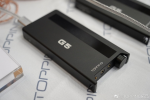I'm not an electronics expert, but maybe because of that I can explain it easier. There are apples and oranges to understand.Hi, I'm trying to understand how the power ratings work.
The review says the S9 reaches 110 mW with 32 ohm headphones. But for example I'm looking at a headphone (ES R-10) that has a sensitivity of 103dB/mW. 103 dB sounds about as loud as I'd even want to listen to headphones.
So does that mean that the S9's output is 110 times more powerful than what I would need for those headphones?
There's gotta be something I'm misunderstanding.
Thanks
Let's use a water analogy, water coming out of a pipe to turn a waterwheel.
The amount of water per second drives how fast the waterwheel turns. The amount of water is the same as amps, the amount of electrons flowing through a wire.. The water pressure is the same as volts. You need both water and pressure or the water won't go through the pipe to turn the water wheel. When you have both water (amps) and pressure (volts), you end up with a flow of water to the waterwheel (watts).
However, we've left out another variable that tells us how much water will reach the water wheel each second. The size of the water pipe determines how much resistance (impedance) the pipe will offer to your flow of water (amps).
So, if the water (amps) is flowing through a big sewer pipe, it can flow pretty freely and the amount of water reaching the waterwheel is based on how much water (amps) you flow into the big pipe. In the same way, a low-impedance headphone will provide a big pipe for your amps, and amps are the important variable to powering those phones. But if you're driving your water (amps) through a pipette, clearly you're going to need a helluva lot more pressure (volts) to overcome the resistance (impedance = ohms) of the tiny pipette. So the crucial variable for your high-impedance headphone, with its tiny pipe is the combination of BOTH water volume (amps) and pressure (volts); i.e. watts.
So we've identified how much water per second (watts) are going to your waterwheel (headphones), but that doesn't tell you how fast the water wheel will spin (how loud the headphones will be). The waterwheel will either be efficient or inefficient in spinning based on the diameter of the impeller, the shape of its blades and its turning resistance. In the same way, your headphones will be louder or softer based on their sensitivity, which is the dB of sound volume per watt of power.
So you've got four variables that determine how loud your headphones will get: (1) volts; (2) amps/current [(1) x (2) = power or watts]; (3) impedance/ohms; and (4) headphone sensitivity.
Now let's go back to your original questions. The sensitivity of your headphones is how loud they'll get per watt (1,000 mW) of power coming in. It's not a measure of the power coming in, or how loud your headphones will be without also knowing watts and impedance. Headphone sensitivity is a characteristic of your headphones, not a power rating for your amp. Three variables, apples and oranges and kumquats, that in combination tell you SPL into your ears.
If you're referring to Amir's review, that was of an earlier version of the S9. The current version of the S9 Pro has 100 mW (single-ended) into 32 ohms impedance. It also has a current-limiter at 90 amps, so that is your maximum amperage. I don't know what headphones you're looking at, but if you know their rated sensitivity and impedance, you can go to the "headphone power calculator" (google that phrase and it should take you there at Headphonesty). Enter the headphone sensitivity dB(1vrms) and impedance, and then enter possible target SPL's until you see where either the required amps go above 90 or the required milliwatts are greater than your headphone's rated mW at that impedance. That should be a rough estimate of the max undistorted SPL you'll get from the Hidizs. Note: if you use the balanced connector instead, the mW will be doubled (except that for very low impedance headphones and/or amps required >90, you'll hit a speed limit).
(That said, some of these specs are estimates or are calculated by manufacturers using non-standard methods. It's nice to get good third party measurements (like Amir's reviews) before you draw any final conclusions.
Last edited:


